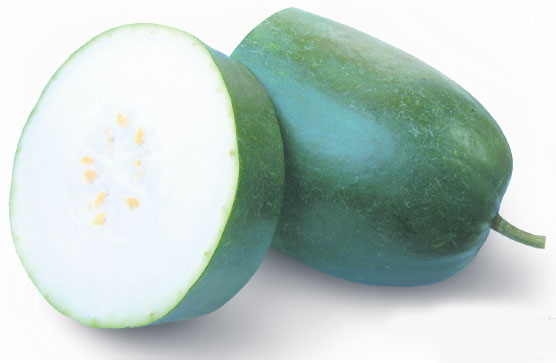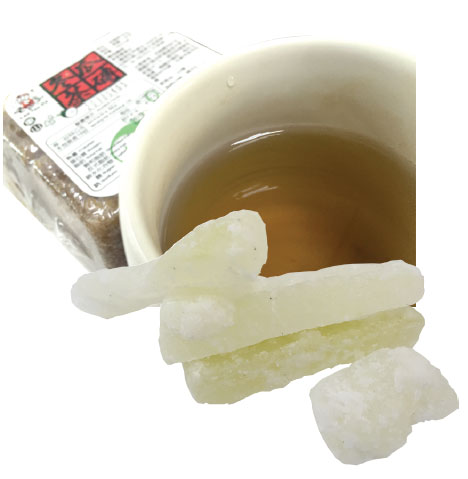A melon for all seasons
Editor's Note: China is divided into as many culinary regions as there are different ethnic groups. Its geographical diversity and kaleidoscopic cultural profiles contribute to the unending banquet of flavors.
Despite its name, the winter melon is more often than not a summer vegetable, although it is eaten all year round. It is also known as wax melon, ash gourd or white gourd mainly because its dark green skin develops a white waxy layer upon maturity.
The plant itself is native to Asia and, although it was introduced to Europe and later the Americas, it is still more commonly eaten in the eastern hemisphere.
|
Winter melon is native to Asia and was introduced to Europe and later the Americas. Provided to China Daily |
|
Winter melon tea and winter melon candy strips. Photo Illustration by Li Jing / China Daily |
That's because Asian cooks have developed a vast variety of ways to coax maximum flavor out of this rather bland vegetable.
It is a hardy vine plant that enjoys warm weather and is planted in spring so the vine can produce fruit that matures in summer and autumn. Shoots and tendrils are also edible, although the melons are the main crops.
Because of its thick waxy protective layer, the winter melon keeps well and is often stored as a winter vegetable long after it is harvested.
The fruits are huge and can grow to about 80 centimeters in length and about 20 cm in diameter, weighing up to 10 kilograms. These large fruits are cut into chunks and sold as more manageable wedges at Chinese markets.
In recent years, smaller varieties have been cultivated and these are still around 1 kg each. The melons are often cooked whole and then scooped out as a container for an assortment of ingredients such as Chinese ham, diced mushrooms, asparagus, fresh corn, prawns and dried scallops among others.
This is the classic banquet dish, known as winter melon broth.
Chefs used to take the larger melons, carefully sculpting the outer skin into intricate designs of white on green. The melon would then be steamed with the cap on and unveiled at the table for a dramatic centerpiece.
These days, modern Chinese chefs prefer to serve individual portions using the miniature melons.
Western kitchens often dismiss the winter melon as watery and tasteless, yet it is precisely these qualities that make it a favorite in the Chinese kitchen. The winter melon's subtlety is appreciated here, and it is often the canvas for richer ingredients because it sponges up the flavors of anything it is cooked with.
When it is prepared with any meat in a soup, the winter melon soaks up the flavors, adding its own clean green accent to the broth that is not unpleasant.
For this reason, the winter melon is enjoyed during hot summers as a refreshing dish. It is also braised, stir-fried and steamed. Sometimes, it is cut into slivers, with thin slices of salty Chinese ham sandwiched in between. The platter is then simply steamed.
The winter melon is also known as the Chinese preserving melon, because it is candied in a variety of ways.
It is cut into batons and cooked in a thick cane sugar syrup and dried. These winter melon candy strips are eaten as they are, especially during the Lunar New Year festivities, or used as a sweetener in soupy desserts.
In certain parts of China, the sweetened dried melons are chopped up and used as fillings for pastries and cakes. A famous example is the laopobing, or marriage cake, distributed to friends and relatives when a happy couple announces their engagement.
They are also often added to rice dumplings, and used in mooncakes as well.
In vegetarian cuisine, candied winter melon is used to replicate the texture of fried lard.
This amazing fruit is also used to make a delicious cooling drink for summer - winter melon tea. Ripe winter melon is first cooked to a pulp and then simmered with raw cane sugar until it forms a very thick jam. It is then further reduced until it is fully caramelized.
In Fujian province and Taiwan, these winter melon fudge pieces are often wrapped in lucky red paper and given to wedding guests as gifts.
Once home, the guests can turn this winter melon rock candy into a very pleasant drink simply known as winter melon tea, made by dissolving it in hot water.
This tea is very popular in the southern provinces, where it is canned and sold as a soft drink. It is very aromatic and has a distinctive taste.
It is one of those unexplainable kitchen miracles that such a watery, mild-tasting vegetable should reduce to such a fragrant syrup.
Of course, the Chinese would not pay attention to the winter melon if it did not have a host of medical benefits. It is above all, a diuretic, and it has significant amounts of calcium, selenium, phosphorous and vitamin C in it to make it worth putting on the table.
paulined@chinadaily.com.cn
Classic melon recipes
Winter melon and Chicken Soup
500g winter melon
1 whole chicken leg

1/2 small carrot
4-5 fresh shiitake mushrooms (or other mushrooms)
1-2 slices ginger
Salt and pepper to taste
Spring onions
Carefully remove the bone from chicken leg. Rinse off the bone and boil it in two liters of water with a sprig of spring onions and a slice of ginger. Bring to a boil, then reduce to a simmer for 30 minutes. This will form the basis of your stock.
Meanwhile, cut the chicken into 1 centimeter cubes. If you like, you can remove the skin, but a little bit of oil will make your soup tastier.
Peel and core the winter melon, and cut it into 1 cm cubes. Do the same for the mushrooms. Peel and thinly slice the carrot. It will add sweetness and color.
Strain the chicken stock and discard the bone, ginger and spring onion. Bring it to a boil again and add the chicken, winter melon, mushroom and carrots. Add the ginger slices. Cook for 10 minutes on high heat, then reduce to a slow simmer for another 10 minutes.
Season with salt and pepper to taste and garnish with finely chopped spring onions.
Winter melon and Chinese ham sandwich
300g winter melon
100g Yunnan ham
1 teaspoon corn starch plus 2 tablespoons water
Half cup chicken stock
Sesame oil and salt to taste
Peel and core the winter melon and cut into half-cm-thick slices.
Thinly slice the ham.
Sandwich a slice of ham between two slices of winter melon and arrange neatly on a plate that can go into the steamer. Do not season at this stage.
Steam the plate on high heat for 15 minutes.
Dissolve the cornstarch in water and add to the chicken stock. Season with a little salt and paper to taste. Bring it to a boil and cook till it thickens. Pour this sauce over the steamed winter melon for a glistening finish. Sprinkle a little sesame oil over.
You hardly need salt in this dish because the Chinese ham is savory enough.
(China Daily European Weekly 06/23/2017 page20)




















